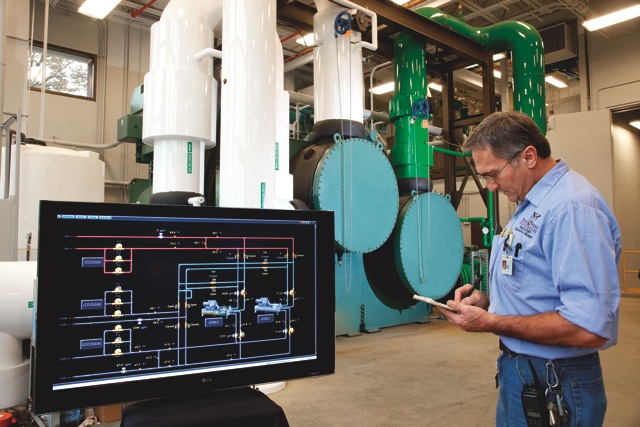Blog Post
Ball State Installs Largest (and most Educational) Ground-Source System in U.S.
The district heating and cooling system will replace coal boilers, cutting the university's carbon footprint in half and saving $2 million a year. It's also a learning opportunity for students.

With 3,600 bore holes, a massive new ground-source heat pump system at Ball State University is going to become the largest system of its kind in the U.S. when it is fully operational in 2014. It is already cooling 47 campus buildings and heating 20, and it will eventually heat and cool all of them, according to the university.
It's part of Ball State's long-standing leadership on green campus issues, including the interdisciplinary Greening of the Campus conference series, in its ninth year, where the new ground-source system was recently dedicated.
Teaching by doing
Projects like this ground-source district heating and cooling system serve not only a university's buildings but also its students. In fact, the theme of the conference this year was "Building Pedagogy." The conference focused strongly on the cross-curricular learning opportunities that are literally under foot (and overhead) everywhere on campus.
Students are already collecting data from the first phase of the district heating and cooling system, and the university will devote an entire building as a learning area for students and the public.
Do green buildings belong in English class?
Our own Jerelyn Wilson co-led a workshop at Greening of the Campus this year with Cynthia Thomashow, education manager at the Association for the Advancement of Sustainability in Higher Education (AASHE), on using campus buildings as teaching tools in the classroom--not only in architecture or engineering classes but also in every other department.
The built environment defines communities and cultures, creating an interface with nature that has implications ranging from the technological to the ethical to the artistic. As Jerelyn and Cynthia emphasized in their workshop, buildings are powerful teachers in all fields of study.
SUPPORT INDEPENDENT SUSTAINABILITY REPORTING
BuildingGreen relies on our premium members, not on advertisers. Help make our work possible.
See membership options »For example, a psychology class could study how students use water in residence halls and what factors make them change their behavior. An English teacher reading early American fiction could take students on a tour of historic campus buildings to help them get a feel for the culture and daily habits of the era. A biology class could compare the biodiversity of an artificial wetland on campus with a natural wetland nearby.
Are you using campus buildings, landscaping projects, or other infrastructure in your classroom? If so, please share your ideas in the comments!
BuildingGreen offers special campus-wide access for high schools, colleges, and universities. Click the link for more information on using these resources in your classroom.

Published March 23, 2012 Permalink Citation
(2012, March 23). Ball State Installs Largest (and most Educational) Ground-Source System in U.S.. Retrieved from https://www.buildinggreen.com/blog/ball-state-installs-largest-and-most-educational-ground-source-system-us



Add new comment
To post a comment, you need to register for a BuildingGreen Basic membership (free) or login to your existing profile.